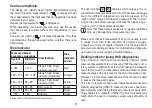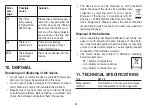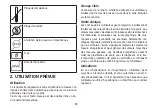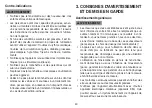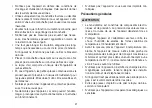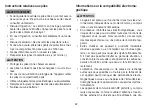
30
31
6.3 Taking a blood pressure measurement
• As described above, attach the cuff and adopt the pos-
ture in which you want to perform the measurement.
• Start the blood pressure monitor with the
START/STOP
button . After the full-screen display, the respective
alarm symbols are displayed if alarm 1
/ 2
is ac-
tivated.
• The cuff automatically inflates. The cuff’s air pressure is
slowly released. If a tendency for high blood pressure is
detected, the cuff re-inflates and the cuff’s pressure is
increased again. As soon as a pulse is found, the pulse
symbol will be displayed.
• The cuff position control symbol
is displayed
throughout the entire measurement. If the cuff is applied
too tightly or too loosely, then
and “
” are dis-
played. In such cases, the measurement is cancelled af-
ter approx. 5 seconds and the device switches itself off.
Apply the cuff correctly and take a new measurement.
• The systolic pressure, diastolic pressure and pulse rate
measurements are displayed. A symbol in the display
also appears which shows you whether you were suffi-
ciently relaxed during the blood pressure measurement
or not (
1
2
symbol = sufficiently at rest;
1
2
symbol = not
at rest). Observe the chapter “evaluating the results/rest-
ing indicator measurement” in these instructions for use.
• You can cancel the measurement at any time by pressing
the
START/STOP
button .
• _ appears if the measurement has not been performed
properly. Observe the chapter on error messages/
trouble shooting in these instructions for use and repeat
the measurement.
• Now select the desired user memory by pressing the
memory button M. If you do not select a user memo-
ry, the measurement is stored in the most recently used
user memory. The relevant , , or symbol appears
on the display.
• To switch off, press the
START/STOP
button . If you
forget to turn off the device, it will switch itself off auto-
matically after approx. 3 minutes.
Wait for at least 1 minute before taking another measurement.
6.4 Evaluating the results
General information about blood pressure
• Blood pressure is always stated in the form of two val-
ues:
• The highest pressure is the
systolic blood pressure
.
This occurs when the heart muscle contracts and blood
is pumped into the blood vessels.
- The lowest pressure is the
diastolic blood pressure
.
This occurs when the heart muscle has completely re-
laxed again and the heart is filling with blood.
• Fluctuations in blood pressure are normal. Even during
repeat measurements, there may be considerable differ-
ences between the measured values. One-off or irregular
measurements therefore do not provide reliable informa-
tion about the actual blood pressure. Reliable assess-
ment is only possible when you perform the measure-
ment regularly under comparable conditions.
















